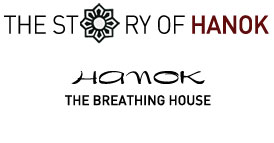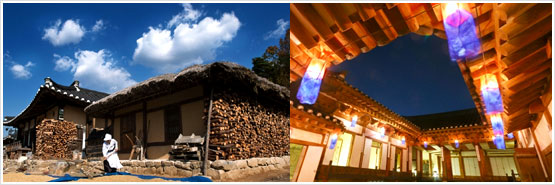
Hanok is the traditional architecture style of Korea. The word hanokembraces all types of traditional architecture including thatched-roof, shingle-roofed and tile-roofed houses. However, these days, the term Hanok is generally understood to mean only the tile-roofed house. While the thatched-roof houses made of straw or shingle-roofed houses have nearly disappeared, the tiled roof Hanok can still be found throughout the country. There are many tiled roof houses which are being maintained as cultural heritages but many are also still private residences.

The Korean style Hanok house is not only the tradition of the past but also an effective architectural style in modern times. The attractiveness of Korean Hanok can be summarized in two points. The first is its scientific excellence, represented most by a unique heating system called the “ondol”. Ondol helps residents endure the cold of winter by heating the floors of the home. The word ondol literally means 'warming the stone And is registered in the Oxford dictionary. ' When heat coming fom the fire in the kitchen is connected to the other rooms, the layer of stone in the floor of thetarget room becomes heated. The warm air at floor level rises, keeping the temperature of the whole room comfortable.
As much of Korean daily life utilizes the floor surfaces, the ondol culture, the core of the family’s indoor temperature control, is always mentioned when discussing Korean In the west, the cold floor is often avoided, with western people preferring to sit on chairs and sleep in beds. However, the comfort of the ondol means that Korean people, rather than avoiding the floor, make full use of it. In fact, the reason why it is necessary to take of ones shoes before entering a house is to keep the floor as clean as possible. This is because the floor is used for both for dining and for sleeping; bedclothes are placed on the warmed floor at night, while during the day, the beds are rolled up and short folding tables are brought out to be used for dining.
The words ‘downside’ and ‘upside’ are both derived from ondol. The floor near the fireplace is heated and is the hottest area when the fire is burning hot. The Korean people are always aware of the need to show respect to the elderly and therefore this area, the downside, is usually reserved for elders of the family. Fires are less necessary during the summer and Korean homes kept cool by utilizing natures cooling system, the movement of air. The Hanok house has fewer walls and more doors. When the door is closed, it becomes a wall and when it is open, it brings in the breeze to keep air circulating throughout the living spaces. That is why the Hanok keeps cool in the heat of summer.
Ondol is also used for medicinal purposes. The Korean language has the phrase ‘sizzling the body’which refers to a kind of fomentation effect that is created if somebody lies on the hot floor in the cold winter. Such fomenting is known as being effective for tired or sick people, pregnant women and the elderly. To this day, Koreans prefer to forment on a toasty ondol floor when they get a cold or other such illness.

Another attraction of the Korean hanok is that it is environmentally friendly. The earth, stone, wood and paper which make up the Hanok are obtained directly from natural sources. Wood is used for pillars, rafters, doors, windows, and flooring. Walls are a mixture of straw and earth. The Korean paper used throughout the house is made from natural wood pulp and is glued to the frame of the sliding doors and the cross ribs of the windows. The floor is polished with bean oil after covering it with Korean paper, making the flooring waterproof. The Hanok breathes on its own because every material is from nature. The wood and earth breath when it is humid indoors and exhale when it is dry.
Koreans built their homes in accordance to geomancy. Houses were positioned after considering the distance and direction in line with mountains and fields as well as the location of water. The direction and structure of the position of the house were decided by this principle. The theory of geomancy is not just a simple superstition. Koreans regard a house built against the background of a mountain and facing the south as being in the most ideal location and certain points have to be taken into consideration when constructing a residential structure, such as limiting the effects of wind off the mountain, adequate ventilation and exposure to sunlight. When considering these points, the hanok is a very practical residential form.
The true beauty of the Hanok is not only skin deep. The true aesthetics of the Korean style house are experienced when viewed from the inside of the house. The outside view varies the view from the inside looking out and these aesthetics of space cannot be experienced without fully exploring the hanok.
Source : visitkorea.or.kr


No comments:
Post a Comment